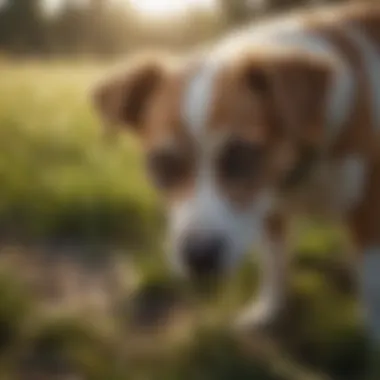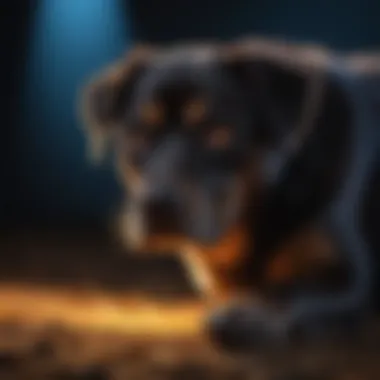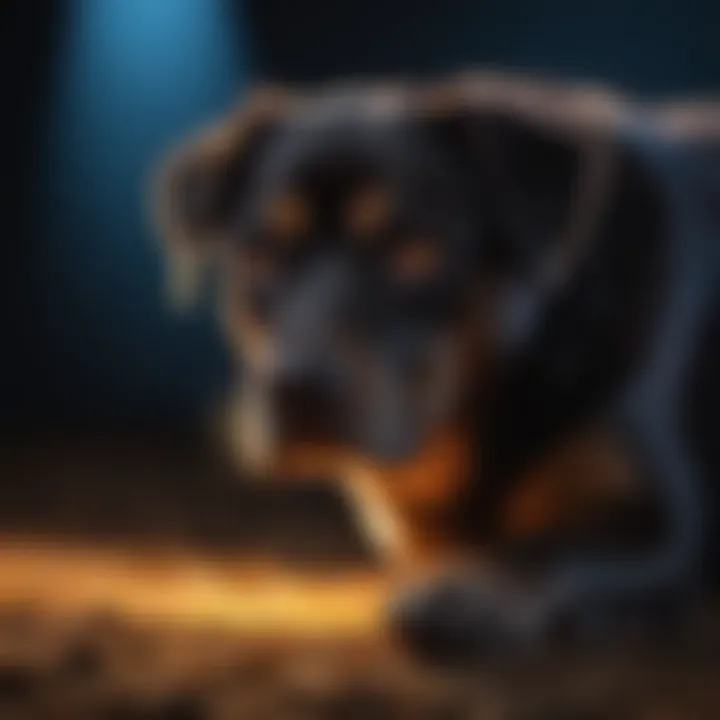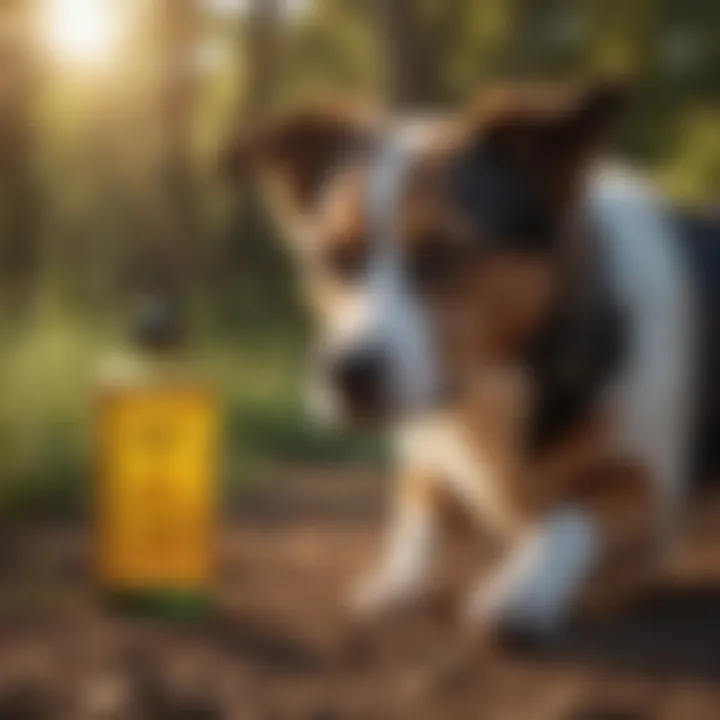How to Effectively Locate Dog Urine in Your Space


Intro
Identifying the location of dog urine can seem like a daunting task for pet owners and caretakers. This situation not only affects the cleanliness of one's home but also poses potential health risks if left unmanaged. Therefore, understanding effective tools and techniques to find and address dog pee is essential for anyone who shares their space with these animals.
The aim of this article is to unravel the complexities associated with dog urine detection. Key methods will be presented, along with practical advice tailored for pet owners, veterinarians, and anyone who engages with dogs. This guide illuminates how to ensure a cleaner, safer environment for both pets and humans.
Overview of the Topic
Definition and Importance
Finding dog pee involves detecting where your pet has urinated in a space, whether it be indoors or outdoors. Dogs, especially puppies, may have accidents frequently, which can create unpleasant odors and stain surfaces. Recognizing where these areas are is pertinent to maintaining hygiene, avoiding damage to property, and promoting the health of both dogs and residents.
Current Trends
With the rise of pet ownership, there has been an increase in products designed to detect urine. Many tools, ranging from UV lights to specially formulated cleaning solutions, are now available. Trends also show that pet owners are more proactive in seeking solutions for hygiene, reflecting a growing awareness of the importance of a clean environment for both pets and people.
Key Techniques and Practices
Step-by-Step Guide
- Visual Inspection: Inspect areas where your dog spends time, as stains can often be found on carpets, upholstery, or flooring. Crouching down might help you see things from a different angle.
- Smell Test: Use your nose to track odors. Older stains may be more difficult to detect but a strong ammonia smell can indicate recent accidents.
- UV Light Detection: A UV flashlight can illuminate old urine spots that might not be visible to the naked eye. This method works well on fabric and hard surfaces.
- Cleaning Products: Many commercial products contain enzymes that can highlight urine spots. Some sprays will turn colors in the presence of urine, providing a clear visual indication.
Tools and Equipment Needed
- UV flashlight: for detecting older stains.
- Cleaning spray with enzymes: helps in cleaning and may indicate urine presence.
- Absorbent pads: to control accidents in areas where pets frequently mark.
- Cloth or sponge: for blotting and cleaning surfaces.
Challenges and Solutions
Common Obstacles
- Hidden Stains: Stains under furniture or in difficult-to-see corners can pose a challenge.
- Odor Linger: Even after cleaning, lingering odors may persist if not treated properly.
- Surface Materials: Different materials absorb urine differently, making detection challenging.
Innovative Solutions
- Using Technology: There are digital devices now designed to detect urine presence.
- Professional Cleaning Services: For persistent odors or stains, hiring professionals can resolve tough issues effectively.
Understanding Dog Urine Composition
Understanding the composition of dog urine is essential for pet owners, especially when it comes to maintaining a clean and healthy environment. Urine can be a nuisance if not properly managed; hence, knowing its chemical makeup can assist in effective detection and cleaning. Moreover, recognizing the indicators that signal the presence of urine can save time and improve hygiene.
Chemical Properties of Dog Urine
Dog urine is primarily composed of water, which accounts for approximately 95% of its total volume. The remaining 5% contains various solutes, including urea, creatinine, ammonia, and electrolytes. Urea is the primary nitrogenous waste product excreted, while creatinine is byproduct of muscle metabolism. Ammonia gives urine its distinct odor, which can be enhanced by factors like diet and hydration levels.
Understanding the chemical properties can help pet owners:
- Identify the source of stains based on odor differences.
- Choose appropriate cleaning agents that can target these compounds.
Common Indicators of Dog Urine Presence
Identifying urine can be challenging, especially in carpets or on non-porous surfaces. However, there are several indicators that can help.
- Color Changes: Surfaces that have absorbed urine usually show discoloration. Look for pale yellow spots, which may indicate where a dog has urinated.
- Odor: A strong, ammonia-like smell is usually a dead giveaway.
- Texture Variations: Surfaces may feel sticky or damp after absorption.
- Fluorescence Under UV Light: When using a black light, dried urine will fluoresce, providing a clear visual clue.
Understanding these indicators not only facilitates detection but also ensures that cleaning is focused and effective.
Common Areas Where Dogs Pee
Understanding common areas where dogs tend to urinate is crucial for pet owners. Not only does it help in quickly identifying and managing urine spots, but it also promotes a healthier living environment. Dogs usually have specific preferences for where they relieve themselves, based on their instincts and learned behavior. Acknowledging these common locations enables owners to implement preventative measures and maintain cleanliness.
This section will discuss various spaces in and around the home where dogs are likely to pee, helping you to better manage their behavior.
In the House
Dogs often choose indoor spaces based on scent, texture, and comfort. Knowing where they tend to urinate can aid in effective cleaning and prevention of future accidents.


Carpets
Carpets serve as common spots for dogs to urinate. The plush texture may seem inviting, encouraging dogs to relieve themselves indoors. The key characteristic of carpets is absorbency, which can make locating stains more difficult. Though carpets are popular for their comfort and warmth, they hold onto moisture that can lead to lingering odors. Additionally, pet urine can cause damage to carpet fibers and underlayment, leading to costly repairs. When addressing dog pee on carpets, immediate response is crucial to prevent stains from setting.
Furniture
Furniture is another area where dogs might pee, especially if they feel anxious or are not trained properly. Sofas and chairs provide a cushioned surface that can trap moisture, making them appealing for a quick relief. Furthermore, furniture is commonly located in areas where pets tend to relax, increasing the risk of accidents. While some pieces can be cleaned, others may absorb odors and stains, making them challenging to maintain. Protective covers can help, but they may not completely solve the issue.
Wall Corners
Wall corners are often overlooked when considering areas where dogs might urinate. Dogs have a natural instinct to mark their territory; thus, corners provide an ideal spot due to vertical space. The texture of the wall can also influence a dog's decision to urinate in that area. Because walls are not absorbent like carpets or furniture, the urine tends to run down and pool, creating distinct stains. Recognizing this behavior is essential for prompt cleaning and deterrent strategies.
In the Yard
Outdoor spaces provide dogs with a variety of options for relieving themselves, and specific areas within a yard can be more appealing than others. Identifying these locations is necessary for maintaining hygiene outdoors.
Plant Beds
Plant beds are often favored by dogs for urination. The soft soil and strong scents can attract them, making this a popular area. The key characteristic of plant beds is their absorbency. However, while they can hide urine from immediate view, prolonged exposure can damage the plants. If left unchecked, this can lead to unhealthy soil conditions. Regular monitoring of these areas is advisable to prevent damage to both plants and the environment.
Concrete Surfaces
Concrete surfaces are practical spaces for dogs to mark their territory. The hard material does not absorb urine, making it easier to spot any accidents. The clean and flat nature of concrete can make it a beneficial choice for training, as it allows for easy cleaning. However, the downside is that concrete surfaces may harbor odors if not cleaned promptly. Thus, regular washing is necessary to maintain hygiene and prevent lingering smells.
Grass Areas
Grass areas are likely the most common outdoor spots for dogs to urinate. The soft texture feels comfortable for dogs, encouraging frequent use. Grass quickly absorbs moisture, which can help with immediate clean-up. However, excessive urination can lead to patches of dead grass, as high nitrogen levels from urine can negatively affect lawn health. Regularly rotating urination areas can help manage this problem while keeping the yard looking good.
"Understanding a dog's preferred urination spots can significantly help owners in maintaining cleanliness and health in both indoor and outdoor spaces."
Recognizing these common locations in your home and yard allows for proactive measures in training, cleaning, and overall management of pet hygiene.
Tools for Locating Dog Pee
Identifying the presence of dog urine can be a difficult task, especially in spaces where it may blend in with other elements. Therefore, the tools you choose play a critical role in this process. Using the right tools not only simplifies the search but also enhances the accuracy of detection. In this section, we will examine two primary tools: black lights and UV detection strips. Each offers distinct advantages and specific applications that can be beneficial when trying to locate dog pee in various environments.
Black Light Usage
Selecting the Right Device
When selecting a black light, quality matters. The best devices emit UV light at wavelengths that make dog urine fluoresce. This fluorescence makes it much easier to spot traces that are otherwise invisible. A key characteristic to look for is the intensity of the UV light. More powerful devices will illuminate stains from greater distances and provide better visibility.
Among various products available, a handheld black light flashlight is a beneficial choice for this article. Its portability allows pet owners to examine multiple spaces—both indoors and outdoors—efficiently.
A unique feature of high-quality black lights is their wavelength adjustment. Some devices offer different settings to optimize performance based on the environment. However, it is important to note that not all black lights are created equal. Some may not have sufficient intensity or adequate wavelength, which could lead to ineffective results.
Testing for Effectiveness
Once you have selected a black light, testing for effectiveness is crucial. This involves checking if your device can successfully identify dog urine on various surfaces. One characteristic of effective testing is the ability to identify previously undetected spots.
Testing should ideally be done in a low-light environment. This allows the fluorescence of the dog urine to be more pronounced. A beneficial approach is to compare results with known clean and contaminated areas. If you can effectively locate all the known stains, your device is likely working correctly.
A unique feature of this testing method is its straightforward approach. It requires no elaborate preparation and provides immediate feedback on the device’s performance. However, challenges may arise if there are similar-colored stains or other substances that also fluoresce, which can lead to confusion during the search.
UV Detection Strips
UV detection strips are another tool that helps in identifying dog urine. These strips are designed to change color when they come into contact with substances found in urine. While not as widely recognized as black lights, their advantage lies in their portability and ease of use. A pet owner can carry a few strips, peel off the backing, and lay them in suspected areas.
The most significant benefit of using UV detection strips is that they require no special lighting conditions. As the strip reacts to urine, it will show a color change even in normal illumination. This makes it easier to check various locations without needing to manipulate the environment.
In summary, both black lights and UV detection strips offer practical solutions for locating dog pee. Each has its unique benefits and challenges, making it essential to select the most suitable tool for your specific needs. By combining these tools with thorough knowledge and planned techniques, pet owners can ensure their living spaces are clean and free of unwanted odors and stains.
Practical Techniques for Finding Dog Urine
Effectively locating dog urine in various environments is crucial for maintaining cleanliness and hygiene in a space shared by pets and humans. By employing practical techniques, pet owners can minimize odor and health risks associated with canine accidents. Understanding these methods not only allows for quick remediation of stains but also aids in preventing future issues. This section delves into vital visual inspection methods and the integration of tools that can enhance the searching process.


Visual Inspection Methods
Identifying Stains
Identifying stains left by dog urine is a fundamental aspect of tracking down its presence. Pet owners should look for dark patches or discoloration, often visible against lighter surfaces. The key characteristic of identifying stains is that they provide immediate visual cues. This method is accessible and effective, requiring no special equipment. The attraction of using stain identification lies in its simplicity and speed, allowing for a quick response to any messes.
One potential disadvantage of only relying on visible stains is that some may be faint or set in over time, making them harder to spot. Such limitations might lead to overlooking persistent issues. However, the unique feature of stain identification is that it can often provide a direct path to an action plan, focusing cleaning efforts where they are most necessary.
Smell Recognition
The sense of smell plays a critical role in identifying dog urine. Many pet owners can detect a distinctive odor linked to dog waste, which helps pinpoint its location even when it is not visible. The key characteristic of smell recognition is its effectiveness in detecting accidents that are not apparent through visual inspection. This method allows for a more comprehensive search, encompassing areas where stains might be absent but odors remain.
A potential limitation of relying solely on smell is the possibility of confusing it with other strong odors in a household. Additionally, in a multi-pet environment, distinguishing the source may be challenging. Nonetheless, the unique feature of smell recognition is its utility in hidden or neglected spots, making it a powerful tool for thorough investigations of odoriferous areas.
Integration of Tools and Techniques
Incorporating tools like black lights or UV detection strips enhances the effectiveness of visual and smell recognition methods. Using these tools can reveal stains and odors that are not detectable by the naked eye, providing a more thorough understanding of the contamination present.
One significant benefit of integrating tools is the opportunity for pet owners to validate their findings. For example, stains that may seem invisible under standard light may shine brightly under a black light, confirming the necessity for cleaning. Tools should complement the techniques of stain identification and smell recognition, allowing for a well-rounded approach to managing the spaces pets inhabit.
By combining various inspection methods with reliable tools, pet owners can achieve a consistent strategy for finding and addressing dog urine in their homes. Such comprehensive efforts lead to healthier living spaces and improved overall hygiene, promoting positive interactions between pets and owners.
The Role of Training in Preventing Accidents
Training is a crucial aspect of pet ownership, especially when it comes to preventing accidents related to dog urine. A well-trained dog not only minimizes the presence of accidents in the home but also contributes positively to the overall hygiene of the environment. Understanding different training techniques can greatly aid in achieving this goal. The ability to effectively communicate with your pet can lead to better behavior, creating a more harmonious living situation for both the owner and the dog.
Training has several advantages. Firstly, it establishes clear expectations for your dog, reducing confusion that could lead to accidents. Secondly, it can improve the bond between you and your pet, as training involves consistent interaction and positive reinforcement. Lastly, effective training can often lead to a more enjoyable experience for the pet, ultimately making the pet easier to manage. Some factors to consider include the age of the dog, individual temperament, and previous experiences.
Housebreaking Techniques
Housebreaking is an essential part of the training process. It is vital to implement consistent techniques that will help your dog learn where it is appropriate to relieve itself.
- Scheduled Potty Breaks: Regular intervals for potty breaks can prevent accidents. Young dogs may need to go out every hour or two, while older dogs may need fewer breaks.
- Designated Potty Areas: Choose a specific spot outside for your dog to relieve itself. This will help the dog associate that area with the act of going to the bathroom.
- Positive Reinforcement: Whenever your dog successfully goes outside, immediately reward it with praise or treats. This reinforces the behavior, encouraging your dog to use the designated area in the future.
- Crate Training: Using a crate can be effective, as dogs naturally avoid soiling their sleeping area. Ensure the crate is not too large, as it can encourage the dog to use one spot for sleeping and another for elimination.
Reinforcement Strategies
Reinforcement strategies play an important role in dog training. These methods can help solidify the understanding of behaviors you want to encourage.
- Consistency: Consistency in commands and expectations will help reduce confusion. Make sure everyone in the household uses the same commands and procedures when training the dog.
- Gradual Increases: Slowly increase the time between potty breaks as your dog becomes more reliable. This helps with building its bladder control.
- Redirecting Behavior: When you catch your dog in the act of an accident indoors, calmly redirect it outside to the designated area. It is essential to do this without yelling, as it can cause fear and confusion.
"Effective training leads to a cleaner home and a healthier, happier dog."
Incorporating these elements into your training regimen can have lasting benefits. Housebreaking techniques and reinforcement strategies work together to create a strong foundation for your dog's bathroom habits. Proper training prevents accidents and fosters a well-adjusted pet that enhances the overall living experience.
Managing Areas Contaminated by Dog Urine
Understanding how to manage areas contaminated by dog urine is essential for keeping both your home and yard clean and healthy. Dog urine can cause unpleasant odors and potential health hazards if not addressed properly. When left unattended, urine can permeate surfaces, leading to long-term damage and attracting further undesirable behavior from pets. Thus, effective management of these areas ensures both cleanliness and a conducive living environment for pets and humans alike.
Cleaning Steps to Follow
When dealing with dog urine, timely action is crucial. The following steps outline an effective cleaning process:
- Act Quickly: As soon as you detect urine, take action to clean it. Fresh urine is easier to remove than dried stains.
- Blot, Don’t Rub: Use paper towels or cloths to blot the area. Rubbing can push the urine deeper into the fibers or surfaces.
- Use Warm Water: After blotting, apply warm water to dilute any residual urine. Blot again to absorb this moisture.
- Choose Cleaning Solutions: Depending on the surface, choose appropriate cleaning solutions. For carpets, a specialized pet cleaner might be necessary.
- For Hard Surfaces: Use plain soap and water or a vinegar solution to clean the area.
- Rinse Thoroughly: Make sure no cleaning residue is left behind, as this can attract pets back to the same spot.
- Dry Completely: Ensure the area is completely dry to prevent odors from lingering.
Following these steps allows pet owners to manage contaminated areas effectively, reducing the likelihood of similar accidents in the future.
Treatment Products Overview
To manage areas contaminated by dog urine, several effective products are available. These products can be divided into two main categories: enzymatic cleaners and odor neutralizers.
Enzymatic Cleaners
Enzymatic cleaners are designed to break down the chemical compounds within dog urine, effectively neutralizing the smell and preventing repeat marking. These cleaners contain enzymes that target proteins and odors. The key characteristic of enzymatic cleaners is their ability to digest the particles that cause odors, making them a popular choice for pet owners.
One unique feature of these cleaners is their effectiveness on various surfaces—including carpets, fabrics, and hard floors. Their advantages include leaving no residual scent that could encourage dogs to re-pee in the same spot. However, some enzymatic cleaners require time to work, needing to sit for a while on the affected area, which may not be feasible for urgent situations.


Odor Neutralizers
Odor neutralizers serve to mask or eliminate unpleasant smells from dog urine. The key characteristic of these products lies in their immediate effect on odors, making them useful for quick fixes. Odor neutralizers are beneficial as they can provide instant relief while waiting for more thorough cleaning methods.
A unique aspect of odor neutralizers is their accessibility, with many available in various forms such as sprays and granules. However, these products may not address the root cause of the odor; if deep cleaning is not done, the problem may persist. Therefore, using odor neutralizers as a short-term solution, while planning for a thorough cleaning, tends to be an effective strategy.
Consistent management of areas contaminated by dog urine is vital not only for cleanliness but also for preventing health issues related to lingering bacteria and odors.
Health Implications of Dog Urine in the Household
Understanding the health implications of dog urine is essential for any pet owner. It reveals potential health risks that can affect both humans and pets. Managing these risks is important for ensuring a safe living environment. Awareness of allergens, irritants, and bacteria significantly contributes to better hygiene practices.
Allergens and Irritants
Dog urine can harbor various allergens and irritants. These are substances that may trigger allergic reactions in sensitive individuals. Urine contains proteins that can provoke responses in some people. Such responses might include sneezing, itching, or a runny nose. Additionally, ammonia, a byproduct of urine breakdown, can cause respiratory problems when inhaled in high concentrations. Therefore, it is wise to address urine marks promptly to reduce exposure to these irritants.
- Common allergens from dog urine:
- Proteins that trigger allergic reactions.
- Ammonia from decomposition.
Regular cleaning routines assist in minimizing allergens and creating a safer atmosphere for everyone. Using proper cleaning techniques and dog urine detectors can enhance health safety in the home.
Bacterial Concerns
Dog urine can also be a carrier for bacteria. Pathogens present in urine can pose risks, particularly to children or those with weakened immune systems. Bacteria from dog urine may contribute to various health conditions if not managed properly. For example, leptospirosis is a disease caused by the bacteria found in urine from infected animals. Symptoms can range from mild flu-like to severe illnesses.
When cleaning urine, it is crucial to utilize products that effectively eliminate bacteria. This means shifting towards enzymatic cleaners that target biological waste. Enzymatic cleaners work by breaking down organic material, thus reducing the risk of bacterial growth.
Overall, addressing both environmental and health aspects related to dog urine is vital. This will not only ensure a cleaner home but also promote wellbeing for both pets and their owners. By being proactive, a healthier living space can be created for everyone.
Long-Term Solutions for Managing Dog Urine
Addressing dog urine effectively requires long-term strategies that promote a cleaner environment over time. Implementing these solutions prevents future incidents and enhances overall hygiene. Without a solid plan, pet owners may face persistent odor and damage, leading to additional costs and stress.
Regular Cleaning Routines
Establishing a consistent cleaning routine is vital in managing dog urine. A well-structured schedule can minimize residue build-up. Consider these steps:
- Daily Maintenance: Spend a few minutes each day to check common areas where dogs tend to urinate. This might include specific spots in the yard or designated areas inside the home. A rapid daily inspection stops stains from becoming permanent.
- Deep Cleaning: Allocate time weekly for more thorough cleaning. Use appropriate cleaning agents such as enzymatic cleaners, which break down urine components.
- Follow-Up Inspections: After cleaning, look for lingering odors or signs of urine. If anything is detected, repeat cleaning as necessary to ensure complete removal. Keeping track of areas that require more attention helps focus future cleaning efforts.
Regularly cleaning not only helps maintain a hygienic space but may also reduce allergen and irritant levels, making environments more comfortable for both pets and humans.
Infrastructure Adjustments for Outdoor Spaces
Modifying the outdoor environment can significantly reduce issues related to dog urine. Consider the following adjustments:
- Designated Urination Areas: Create specific zones for dogs to relieve themselves. This could involve using gravel or synthetic grass. By concentrating urine in a designated area, it becomes easier to manage and clean up.
- Drainage Enhancements: Improve drainage in outdoor spaces to prevent urine pooling. Ensuring proper drainage reduces odor and keeps the area sanitary. Consider consulting with landscape professionals for effective solutions.
- Landscaping Choices: Opt for grass or plants that are more resistant to urine damage. Native plant options tend to withstand pet waste better than others. By understanding which flora thrives despite these conditions, you can enhance outdoor aesthetics while supporting your dog's needs.
Making structural adjustments to the space your dog frequents is a proactive approach that lowers the risks of contamination and damage, creating a more pleasant area for everyone.
Utilizing these long-term solutions allows pet owners to maintain clean environments, reducing stress associated with unexpected urine incidents while promoting the well-being of their pets.
End
In this guide, we addressed the crucial topic of locating dog urine in various environments. Understanding this subject is vital for any pet owner, caretaker, or professional involved with animals. This knowledge aids in maintaining a clean, hygienic space, which contributes to the well-being of both pets and people. Furthermore, efficient urine detection can prevent potential issues related to health hazards and odors that arise from neglecting canine waste.
A key element of successful urine detection is the integration of various practices and tools. Employing black lights or UV detection strips enhances the ability to find urine stains that might not be visible to the naked eye. These methods, coupled with practical inspection techniques, provide a thorough approach to tackling the issue of dog urine in your home or yard.
Moreover, understanding the chemical makeup of dog urine can also inform owners about potential risks and preventive measures, such as implementing regular cleaning routines and adjusting outdoor spaces. This multifaceted strategy not only addresses immediate concerns but also promotes a long-term solution to maintaining hygiene.
Ultimately, being proactive in this regard is beneficial for everyone involved. A clean environment results in healthier pets and a more pleasant living space, reinforcing the importance of diligent care and management regarding dog urine.
Summary of Key Points
- Locating dog urine is essential for maintaining hygiene.
- Tools such as black lights and UV detection strips can enhance urine detection.
- Regular cleaning and infrastructure adjustments help manage long-term issues.
- Understanding urine's chemical properties aids in prevention and care.
Encouragement for Pet Owners
Pet ownership introduces numerous responsibilities, and understanding how to manage canine waste is among the most important. While finding and cleaning dog urine may seem daunting initially, developing these skills is crucial for a cleaner home. Regular inspections, combined with the right tools, can greatly simplify the task.
Encouraging best practices not only benefits your immediate environment but also enhances your pet's health. Stay proactive in your cleaning efforts and routine checks. It's an investment in the quality of your living space and the welfare of your loyal companion.



